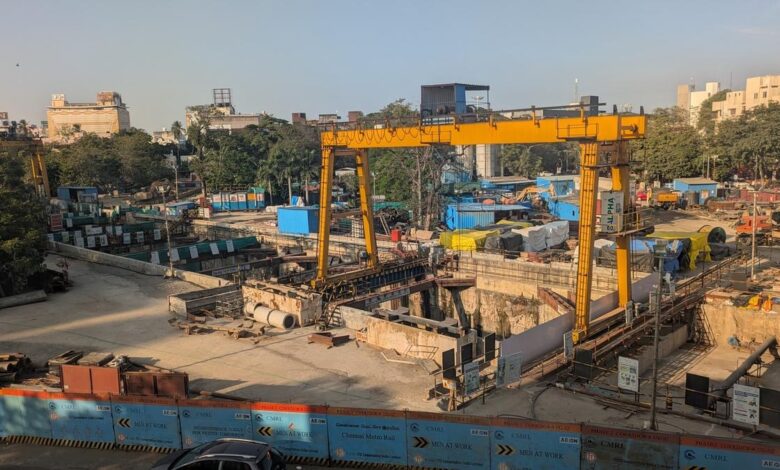
Chennai, India – In a significant milestone for Chennai’s urban transit project, Chennai Metro Rail has announced that its tunnel boring machine (TBM) from Panagal Park has successfully reached Kodambakkam after a year of continuous work. This achievement marks a pivotal moment in the ongoing construction efforts, although the project has encountered delays. The TBM, affectionately nicknamed ‘Pelican’, is now slated to make its breakthrough near Meenakshi College in June, while the second machine, ‘Peacock’, trailing by approximately 150 meters, is expected to complete its work by July.
A Year-Long Journey from Panagal Park to Kodambakkam
The ambitious project, spearheaded by Chennai Metro Rail, began tunnelling from Panagal Park nearly a year ago. Despite facing several technical and logistical challenges, the dedicated team of engineers and workers has persevered. Their relentless efforts have now culminated in Pelican reaching the bustling area of Kodambakkam, an important landmark in the city’s urban grid.
“This is a landmark achievement that not only demonstrates our technical prowess but also reinforces our commitment to transforming Chennai’s transit landscape,” stated a senior official from Chennai Metro Rail.
‘Pelican’: Overcoming Delays to Make a Breakthrough
While Pelican has made impressive progress by reaching Kodambakkam, the project has experienced delays that have pushed the schedule for its breakthrough. Originally expected to complete its advance earlier, unforeseen challenges—ranging from complex underground conditions to coordination issues in densely built urban areas—have contributed to the setback.
According to project managers, Pelican is now on track to make its much-anticipated breakthrough near Meenakshi College in June. This breakthrough is crucial, as it will allow the tunnel to transition into the next phase of construction, connecting critical transit nodes and enhancing connectivity for commuters.
“Delays are an inherent part of large-scale infrastructure projects. However, our teams have adapted to the challenges, and we are confident that the breakthrough near Meenakshi College will set us back on schedule,” added the official.
‘Peacock’: The Second TBM Gearing Up to Complete the Work
Complementing the progress of Pelican is the second tunnel boring machine, ‘Peacock’. Currently operating approximately 150 meters behind Pelican, Peacock plays a vital role in ensuring the continuity of the tunnel construction. Despite being slightly behind schedule, projections indicate that Peacock is well-positioned to complete its assigned section by July.
The coordinated efforts between Pelican and Peacock highlight the strategic planning behind the project. By working in tandem, the two machines are set to significantly accelerate the pace of tunnelling, ensuring that the metro line will eventually offer a seamless travel experience across key regions of Chennai.
Impact on Commuters and Urban Connectivity
The tunnel’s progress is anticipated to bring transformative changes for residents, particularly those residing in areas like Kolathur, Villivakkam, Mylapore, Adyar, and along the OMR corridor. Once operational, the metro line will reduce commute times and alleviate the perennial traffic congestion that plagues Chennai. Urban planners and local authorities are optimistic that improved connectivity will spur economic growth, enhance real estate values, and elevate the quality of life for millions of commuters.
Local residents have expressed hope and enthusiasm about the project. Many believe that the new metro line will not only streamline their daily commutes but also foster a more sustainable urban environment by reducing reliance on private vehicles.
Technical and Logistical Challenges
The progress of the Chennai Metro Rail project has not been without its challenges. Tunnelling in densely populated urban areas like Kodambakkam presents unique difficulties. The engineering teams have had to navigate complex geological formations and ensure that the construction does not disrupt the surrounding infrastructure.
Additionally, the synchronization between the two TBMs, Pelican and Peacock, requires precise planning and real-time coordination. Despite these challenges, the successful advancement of Pelican and the steady progress of Peacock underscore the resilience and expertise of the project teams.
Looking Ahead: Future Milestones and Expectations
With the breakthrough near Meenakshi College expected in June and Peacock set to complete its work by July, the project is poised to enter its next phase. The subsequent steps will involve connecting the newly tunneled sections with the broader metro network and commencing the installation of tracks and station infrastructure.
Officials are confident that, despite earlier delays, the project will ultimately adhere to its revised timeline. The transformative impact of the metro line on Chennai’s urban mobility is eagerly anticipated by both the government and the public.
“Our commitment to modernizing Chennai’s public transportation remains unwavering. We appreciate the patience of our citizens and are dedicated to delivering a world-class metro system that will serve the city for generations to come,” affirmed the senior official.
Conclusion
The recent milestone achieved by Chennai Metro Rail—with Pelican reaching Kodambakkam—marks a significant step forward in the city’s ambitious metro project. Although delays have postponed Pelican’s breakthrough until June and Peacock is trailing slightly, the progress is undeniable. These developments promise to usher in improved connectivity for key regions of Chennai, transforming the daily commute and contributing to a more vibrant urban future.
As Chennai continues its journey toward a modern, efficient, and sustainable transit system, residents and stakeholders alike remain hopeful that these investments will yield lasting benefits.










